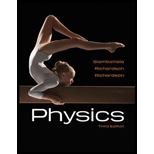
Concept explainers
(a)
The Planck’s constant from the graph given in question.
(a)
Answer to Problem 61P
The Planck’s constant from the graph given in question is
Explanation of Solution
Write Einstein’s
Here,
Write the expression for the kinetic energy of the electron.
Here,
Substitute
Write the general equation of straight line in
Here,
Equation (II) and (III) indicates that,
Write the expression for the slope of straight line in stopping potential versus frequency graph.
Here,
Conclusion:
The slope of stopping potential versus frequency graph given in question gives that value of
From graph, stopping potential at
Substitute
It is found that slope is equal to
Equate slope obtained with
Substitute
Therefore, the Planck’s constant from the graph given in question is
(b)
The work function of the metal from the data.
(b)
Answer to Problem 61P
The work function of the metal from the data is
Explanation of Solution
Rewrite equation (II) .
In graph, the straight-line intercept the
The threshold frequency of the metal from the graph is
Substitute
Here,
Conclusion:
Substitute
Therefore, the work function of the metal from the data is
Want to see more full solutions like this?
Chapter 27 Solutions
Physics - With Connect Access
 College PhysicsPhysicsISBN:9781305952300Author:Raymond A. Serway, Chris VuillePublisher:Cengage Learning
College PhysicsPhysicsISBN:9781305952300Author:Raymond A. Serway, Chris VuillePublisher:Cengage Learning University Physics (14th Edition)PhysicsISBN:9780133969290Author:Hugh D. Young, Roger A. FreedmanPublisher:PEARSON
University Physics (14th Edition)PhysicsISBN:9780133969290Author:Hugh D. Young, Roger A. FreedmanPublisher:PEARSON Introduction To Quantum MechanicsPhysicsISBN:9781107189638Author:Griffiths, David J., Schroeter, Darrell F.Publisher:Cambridge University Press
Introduction To Quantum MechanicsPhysicsISBN:9781107189638Author:Griffiths, David J., Schroeter, Darrell F.Publisher:Cambridge University Press Physics for Scientists and EngineersPhysicsISBN:9781337553278Author:Raymond A. Serway, John W. JewettPublisher:Cengage Learning
Physics for Scientists and EngineersPhysicsISBN:9781337553278Author:Raymond A. Serway, John W. JewettPublisher:Cengage Learning Lecture- Tutorials for Introductory AstronomyPhysicsISBN:9780321820464Author:Edward E. Prather, Tim P. Slater, Jeff P. Adams, Gina BrissendenPublisher:Addison-Wesley
Lecture- Tutorials for Introductory AstronomyPhysicsISBN:9780321820464Author:Edward E. Prather, Tim P. Slater, Jeff P. Adams, Gina BrissendenPublisher:Addison-Wesley College Physics: A Strategic Approach (4th Editio...PhysicsISBN:9780134609034Author:Randall D. Knight (Professor Emeritus), Brian Jones, Stuart FieldPublisher:PEARSON
College Physics: A Strategic Approach (4th Editio...PhysicsISBN:9780134609034Author:Randall D. Knight (Professor Emeritus), Brian Jones, Stuart FieldPublisher:PEARSON





